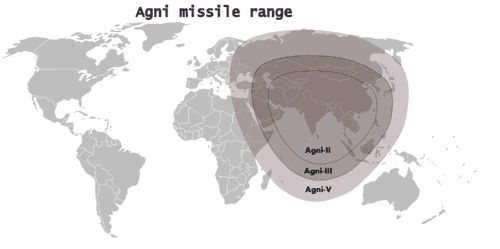Agni-V ICBM test scheduled for December
04 Jun 2011
New Delhi: India will test its longest range strategic missile, Agni-V, which will have near-ICBM (intercontinental ballistic missile) capabilities, this December. Also, in a fresh revelation, a senior defence official said that India's 3,500 km range Agni-III intermediate range ballistic missile has already been inducted into the armed forces and serialised production of the weapon system has begun.
According to Dr VK Saraswat, scientific advisor to the defence minister and director general of the Defence Research and Development Organisation (DRDO), the Agni-III is an inducted missile:"… there is no confusion whether or when it will be inducted. Agni-III is an inducted missile. It has completed its complete development and is under production."
Dr Saraswat was speaking at the annual DRDO awards function, which was presided over by defence minister AK Antony.
At the ceremony, defence minister Antony also asked the DRDO to prioritise development of the 5,000-km range ballistic missile and also build a ''credible missile defence system'' for the country.
An Inter-continental ballistic missile (ICBM) capability needs a missile to have a range of 5,500 km, which the Agni-V would miss by a whisker.

Talking of the Agni-V, Antony said, ''DRDO must demonstrate the capability to develop missiles of the range of 5,000 km at the earliest. This is a challenge for the DRDO and I hope they will successfully meet this challenge at the earliest.''
The Agni-V is designed to be a road mobile, fast-reaction capable missile with a strike range over 5,000 km. Such range would bring China's northernmost regions in India's nuclear strike envelope.
The armed forces have already inducted and made operational the Pakistan-specific Agni-I (700 km) and Agni-II (over 2,000 km) missiles.
The Agni-V is designed for easy storage as it's a canister-launched system, unlike earlier Agni missiles.
The Agni-V would also be MIRV (multiple independently targetable re-entry vehicles) capable, with such warheads being concurrently developed. A single MIRV-ed missile can deliver multiple warheads at different targets even if they are separated by long distances.
"We have tested the three (solid-propellant, composite rocket motor) stages of Agni-V independently...all ground tests are now over. The integration process is now in progress. We want to test the missile in December, not let it spill over to 2012," Dr VK Saraswat told reporters at the meet.
The Agni-V will incorporate advanced technologies such as ring laser gyroscope and an accelerator for navigation and guidance.
Antony congratulated the DRDO for developing the interceptor missiles that put India into the same elite club of nations possessing such advance technology. Addressing the gathering of defence scientists, he said, "The interceptor missile development programme has taken India into an elite club of nations that possess the capability to demonstrate and deploy missile defence. DRDO should now work towards developing a credible ballistic missile defence for our country."
India is in the process of developing its own BMD system and has carried out six tests in the last two years, of which four have been successful.
The BMD programme comprises a two-tiered system called Prithvi Air Defence (PAD) for high-altitude interception at 50-80 km and Advanced Air Defence (AAD) for low-altitude interception 15-30 km.













.jpg)






.jpg)









